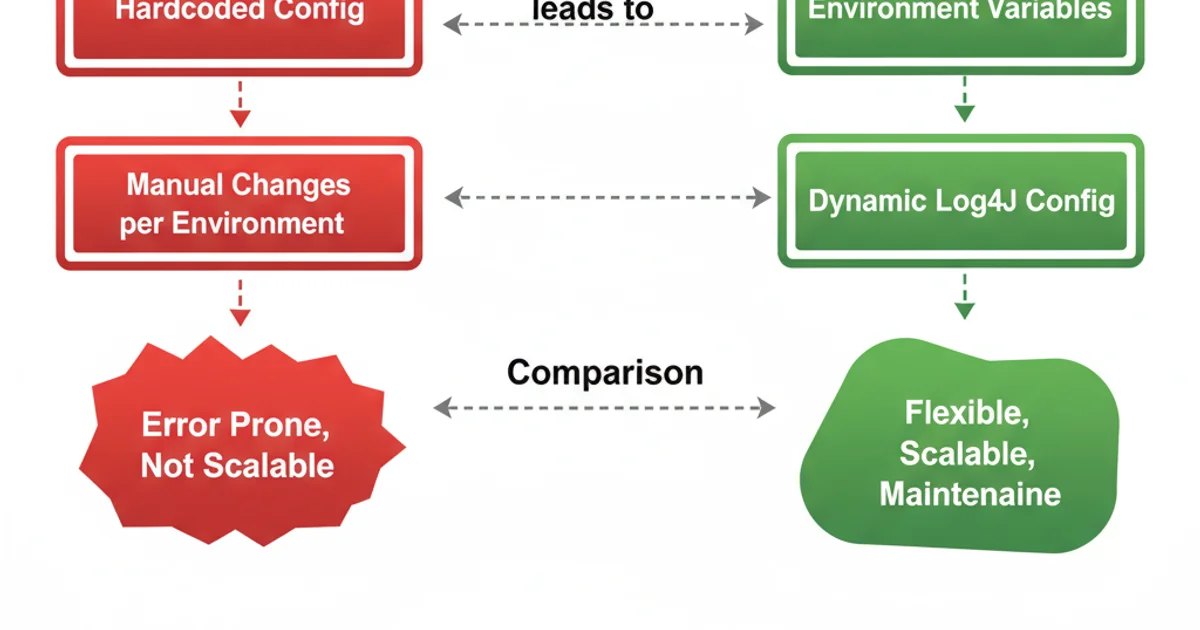Using system environment variables in log4j xml configuration
Categories:
Leveraging System Environment Variables in Log4j XML Configuration

Learn how to dynamically configure Log4j properties using system environment variables, enhancing flexibility and portability across different deployment environments.
Configuring logging in applications often requires flexibility, especially when deploying across various environments (development, staging, production). Hardcoding paths or values directly into your log4j.xml can lead to maintenance headaches and errors. This article explores how to use system environment variables to inject dynamic values into your Log4j XML configuration, making your logging setup more robust and adaptable.
The Need for Dynamic Log4j Configuration
In a typical application lifecycle, log file locations, logging levels, or even appender types might vary. For instance, a development environment might log to a local file, while production might send logs to a centralized logging service or a specific network path. Manually changing the log4j.xml file for each environment is error-prone and not scalable. Environment variables provide a clean, external mechanism to manage these differences without altering the application's core configuration files.

Comparison of hardcoded vs. dynamic Log4j configuration
Using System Environment Variables in log4j.xml
Log4j (versions 1.x and 2.x) provides mechanisms to resolve variables within its configuration files. For system environment variables, you can typically use a specific syntax that Log4j interprets at initialization time. This allows you to define properties outside your application, which Log4j then picks up.
${env:VAR_NAME} for Log4j 2.x).Log4j 1.x: Leveraging System.getProperty()
Log4j 1.x can directly resolve system properties. If you set an environment variable, you can then access it as a system property. There are two primary ways to achieve this:
- Directly referencing system properties: Log4j 1.x allows you to reference system properties using the
${property_name}syntax. If an environment variable is set and then explicitly passed as a system property to the JVM, Log4j can pick it up. - Using a custom
PropertyConverter(more advanced): For direct environment variable access without setting system properties, you might need a customPropertyConverter, but this is generally overkill for simple path configurations.
The most straightforward approach is to pass environment variables as system properties to the JVM when starting your application. This makes them accessible to Log4j's property substitution mechanism.
<?xml version="1.0" encoding="UTF-8" ?>
<!DOCTYPE log4j SYSTEM "log4j.dtd">
<log4j:configuration xmlns:log4j="http://jakarta.apache.org/log4j/">
<!-- Define a property that will be resolved from a system property -->
<appender name="FILE" class="org.apache.log4j.DailyRollingFileAppender">
<!-- The value of LOG_FILE_PATH will be taken from a system property -->
<param name="File" value="${LOG_FILE_PATH}/application.log"/>
<param name="Append" value="true"/>
<param name="DatePattern" value=".yyyy-MM-dd"/>
<layout class="org.apache.log4j.PatternLayout">
<param name="ConversionPattern" value="%d{yyyy-MM-dd HH:mm:ss} %-5p %c{1}:%L - %m%n"/>
</layout>
</appender>
<root>
<level value="INFO"/>
<appender-ref ref="FILE"/>
</root>
</log4j:configuration>
Log4j 1.x XML configuration using a system property placeholder.
How to Set and Use Environment Variables
To make the LOG_FILE_PATH variable available to your Log4j configuration, you need to set it as an environment variable and then pass it as a system property to your Java application.
1. Set the environment variable (Operating System Level)
Before running your Java application, set the environment variable. The method varies by operating system:
2. Pass the environment variable as a system property to the JVM
When you start your Java application, use the -D flag to pass the environment variable's value as a system property. The JVM will then make this property available to Log4j.
Linux/macOS
export LOG_FILE_PATH="/var/log/my-app"
java -DLOG_FILE_PATH="$LOG_FILE_PATH" -jar myapp.jar
Windows (Command Prompt)
set LOG_FILE_PATH=C:\logs\my-app
java -DLOG_FILE_PATH="%LOG_FILE_PATH%" -jar myapp.jar
Windows (PowerShell)
$env:LOG_FILE_PATH="C:\logs\my-app"
java -DLOG_FILE_PATH="$env:LOG_FILE_PATH" -jar myapp.jar
LOG_FILE_PATH.Benefits and Best Practices
Using environment variables for Log4j configuration offers several advantages:
- Portability: Easily move your application between environments without modifying configuration files.
- Security: Avoid hardcoding sensitive paths or credentials directly into your source code or configuration files.
- Maintainability: Centralize environment-specific settings, simplifying updates and reducing errors.
- Flexibility: Quickly change logging behavior without redeploying the application (if the application reloads its configuration).
Best Practices:
- Clear Naming: Use descriptive names for your environment variables (e.g.,
APP_LOG_DIR,LOG_LEVEL_OVERRIDE). - Documentation: Document which environment variables your application expects and their purpose.
- Default Values: Consider providing default values in your
log4j.xmlif the environment variable is not set, to ensure graceful degradation. - Containerization: This approach is particularly powerful in containerized environments (Docker, Kubernetes), where environment variables are a standard way to configure applications.
<?xml version="1.0" encoding="UTF-8" ?>
<!DOCTYPE log4j SYSTEM "log4j.dtd">
<log4j:configuration xmlns:log4j="http://jakarta.apache.org/log4j/">
<!-- Define a property with a default value -->
<property name="log.file.path" value="${LOG_FILE_PATH:-/tmp/logs}"/>
<appender name="FILE" class="org.apache.log4j.DailyRollingFileAppender">
<param name="File" value="${log.file.path}/application.log"/>
<param name="Append" value="true"/>
<param name="DatePattern" value=".yyyy-MM-dd"/>
<layout class="org.apache.log4j.PatternLayout">
<param name="ConversionPattern" value="%d{yyyy-MM-dd HH:mm:ss} %-5p %c{1}:%L - %m%n"/>
</layout>
</appender>
<root>
<level value="INFO"/>
<appender-ref ref="FILE"/>
</root>
</log4j:configuration>
Log4j 1.x XML configuration with a default value for log.file.path using ${LOG_FILE_PATH:-/tmp/logs}.
By following these guidelines, you can create a highly flexible and maintainable logging infrastructure for your Java applications.